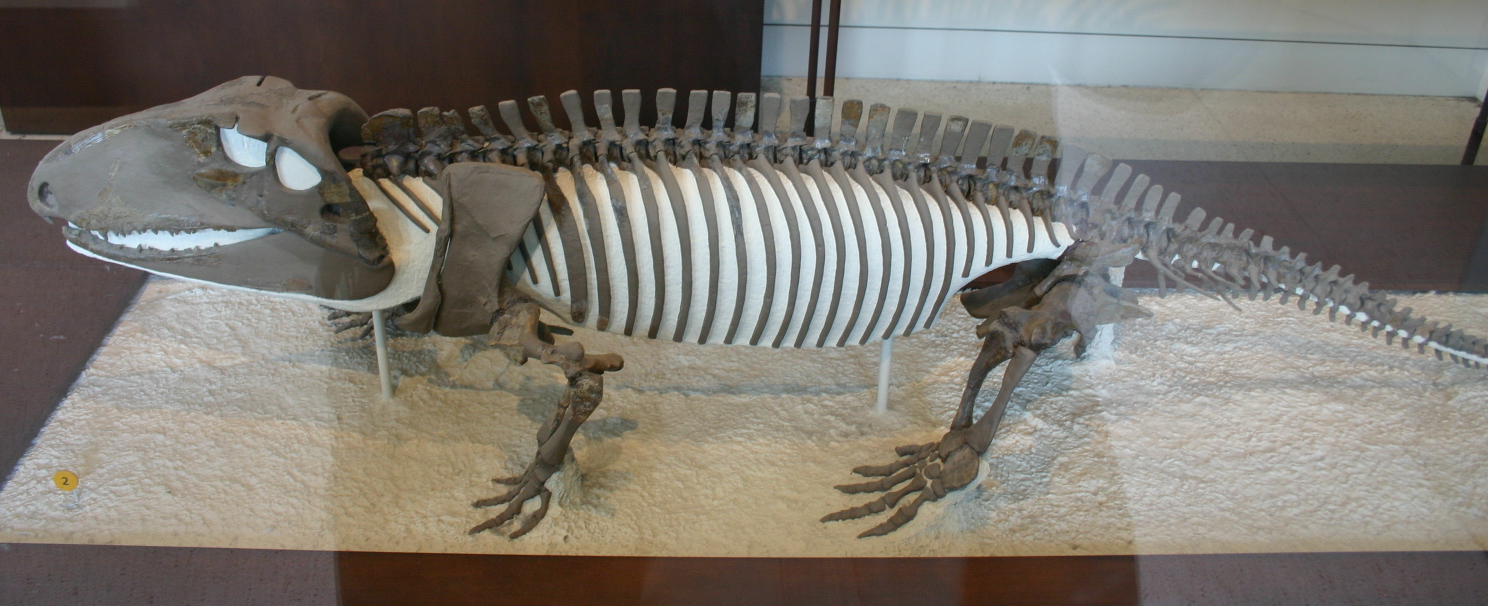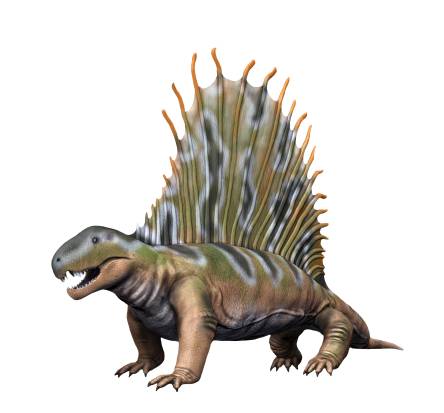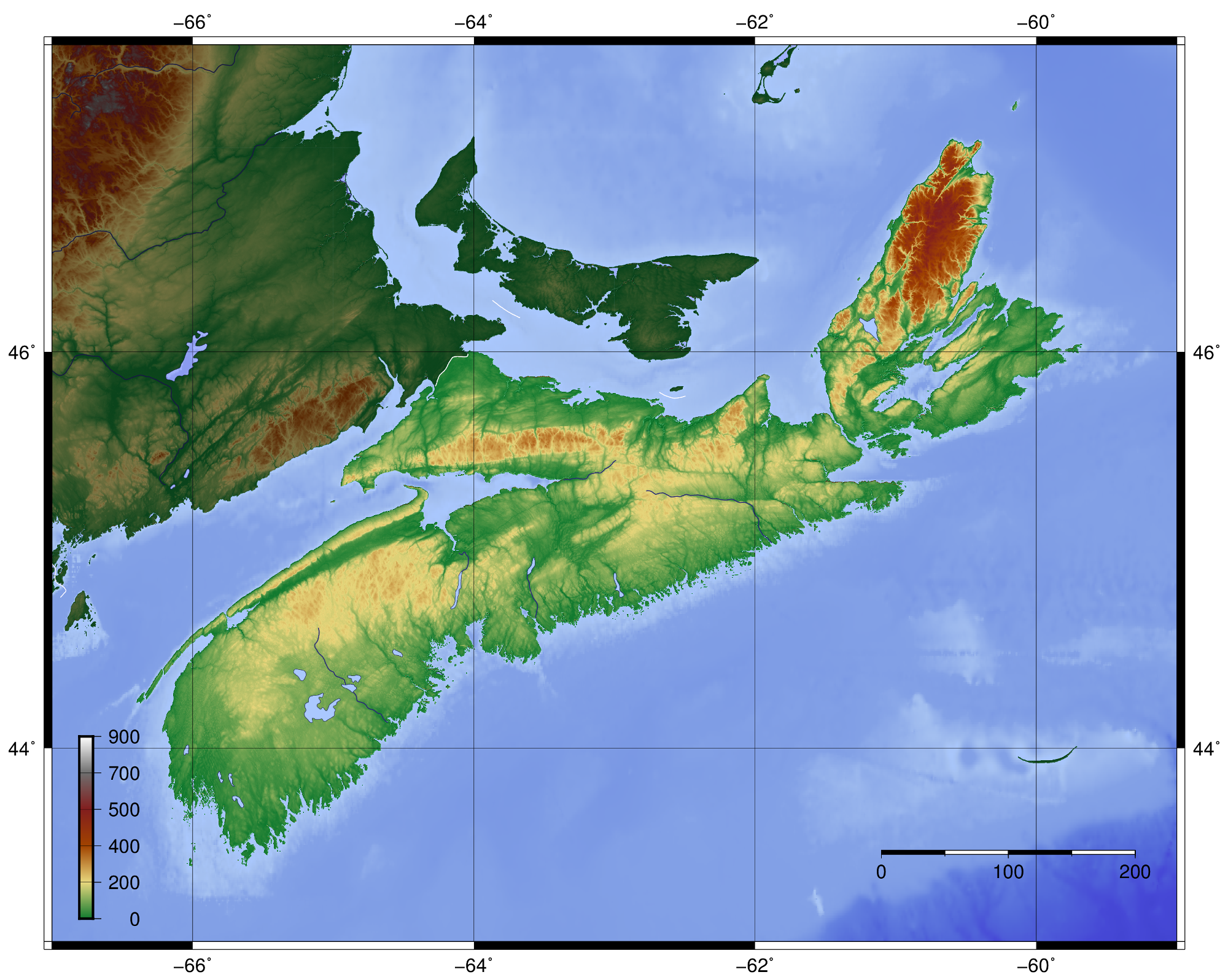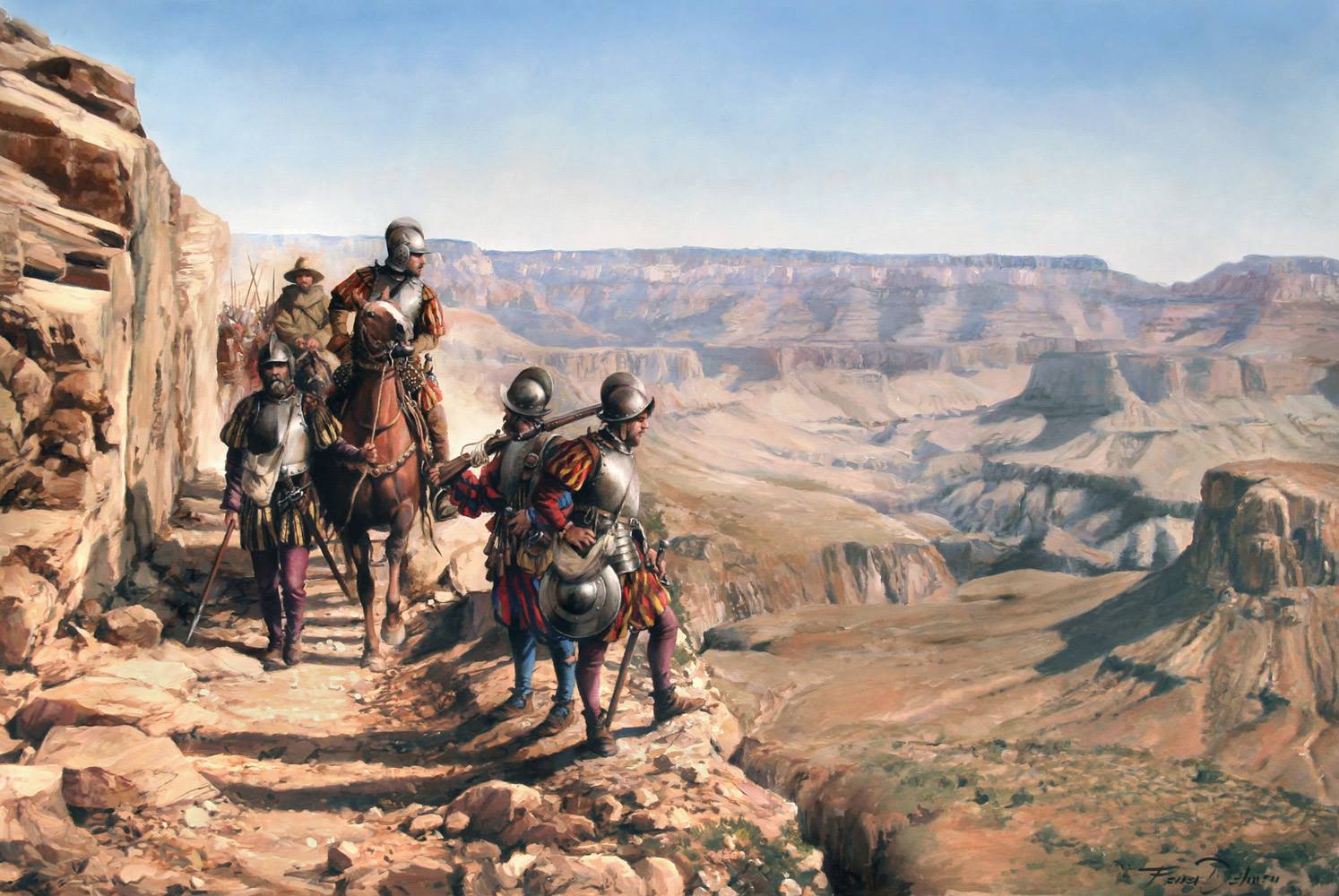|
Ophiacodon
''Ophiacodon'' (meaning "snake tooth") is an extinct genus of synapsid belonging to the family Ophiacodontidae that lived from the Late Carboniferous to the Early Permian in North America and Europe. The genus was named along with its type species ''O. mirus'' by paleontologist Othniel Charles Marsh in 1878 and currently includes five other species. As an ophiacodontid, ''Ophiacodon'' is one of the most basal synapsids and is close to the evolutionary line leading to mammals. Description ''Ophiacodon'' has a large skull with a deep snout. It has the longest skull of any early synapsid, reaching up to in one specimen. The jaws are lined with many small teeth. It was larger than most other tetrapods (four-limbed vertebrates) of its time, ranging from in length and in weight. Specimens of ''Ophiacodon'' vary greatly in size. These differences in size were once used to distinguish species, but are now recognized as ontogenetic variations related to the ages of individua ... [...More Info...] [...Related Items...] OR: [Wikipedia] [Google] [Baidu] |
Ophiacodon Retroversus
''Ophiacodon'' (meaning "snake tooth") is an extinct genus of synapsid belonging to the family Ophiacodontidae that lived from the Late Carboniferous to the Early Permian in North America and Europe. The genus was named along with its type species ''O. mirus'' by paleontologist Othniel Charles Marsh in 1878 and currently includes five other species. As an ophiacodontid, ''Ophiacodon'' is one of the most basal synapsids and is close to the evolutionary line leading to mammals. Description ''Ophiacodon'' has a large skull with a deep snout. It has the longest skull of any early synapsid, reaching up to in one specimen. The jaws are lined with many small teeth. It was larger than most other tetrapods (four-limbed vertebrates) of its time, ranging from in length and in weight. Specimens of ''Ophiacodon'' vary greatly in size. These differences in size were once used to distinguish species, but are now recognized as ontogenetic variations related to the ages of individuals. Sm ... [...More Info...] [...Related Items...] OR: [Wikipedia] [Google] [Baidu] |
Ophiacodontidae
Ophiacodontidae is an extinct family of early eupelycosaurs from the Carboniferous and Permian. '' Archaeothyris'', and ''Clepsydrops'' were among the earliest ophiacodontids, appearing in the Late Carboniferous. Ophiacodontids are among the most basal synapsids, an offshoot of the lineage which includes therapsids and their descendants, the mammals. The group became extinct by the Middle Permian, replaced by anomodonts, theriodonts, and the diapsid reptiles. Characteristics The lifestyle of ophiacodonts has long been controversial. Some studies suggested that they were semi-aquatic, and some even suggested a fairly aquatic lifestyle, but a recent study based on a quantitative inference model suggested that both ''Clepsydrops'' and ''Ophiacodon'' were terrestrial. Vertebral morphometric data also support, though ambiguously, a rather terrestrial lifestyle for ''Ophiacodon'', which could reach a length of . '' Archaeothyris'' may also have been terrestrial, but no detailed st ... [...More Info...] [...Related Items...] OR: [Wikipedia] [Google] [Baidu] |
Synapsid
Synapsids + (, 'arch') > () "having a fused arch"; synonymous with ''theropsids'' (Greek, "beast-face") are one of the two major groups of animals that evolved from basal amniotes, the other being the sauropsids, the group that includes reptiles and birds. The group includes mammals and every animal more closely related to mammals than to sauropsids. Unlike other amniotes, synapsids have a single temporal fenestra, an opening low in the skull roof behind each eye orbit, leaving a bony arch beneath each; this accounts for their name. The distinctive temporal fenestra developed about 318 million years ago during the Late Carboniferous period, when synapsids and sauropsids diverged, but was subsequently merged with the orbit in early mammals. Traditionally, non-mammalian synapsids were believed to have evolved from reptiles, and therefore described as mammal-like reptiles in classical systematics, and primitive synapsids were also referred to as pelycosaurs, or pelyc ... [...More Info...] [...Related Items...] OR: [Wikipedia] [Google] [Baidu] |
Dimetrodon
''Dimetrodon'' ( or ,) meaning "two measures of teeth,” is an extinct genus of non- mammalian synapsid that lived during the Cisuralian (Early Permian), around 295–272 million years ago (Mya). It is a member of the family Sphenacodontidae. The most prominent feature of ''Dimetrodon'' is the large neural spine sail on its back formed by elongated spines extending from the vertebrae. It walked on four legs and had a tall, curved skull with large teeth of different sizes set along the jaws. Most fossils have been found in the Southwestern United States, the majority coming from a geological deposit called the Red Beds of Texas and Oklahoma. More recently, its fossils have been found in Germany. Over a dozen species have been named since the genus was first erected in 1878. ''Dimetrodon'' is often mistaken for a dinosaur or as a contemporary of dinosaurs in popular culture, but it became extinct some 40 million years before the first appearance of dinosaurs. Rept ... [...More Info...] [...Related Items...] OR: [Wikipedia] [Google] [Baidu] |
Field Museum Of Natural History
The Field Museum of Natural History (FMNH), also known as The Field Museum, is a natural history museum in Chicago, Illinois, and is one of the largest such museums in the world. The museum is popular for the size and quality of its educational and scientific programs, and its extensive scientific-specimen and artifact collections. The permanent exhibitions, which attract up to two million visitors annually, include fossils, current cultures from around the world, and interactive programming demonstrating today's urgent conservation needs. The museum is named in honor of its first major benefactor, Marshall Field, the department-store magnate. The museum and its collections originated from the 1893 World's Columbian Exposition and the artifacts displayed at the fair. The museum maintains a temporary exhibition program of traveling shows as well as in-house produced topical exhibitions. The professional staff maintains collections of over 24 million specimens and objects t ... [...More Info...] [...Related Items...] OR: [Wikipedia] [Google] [Baidu] |
United States
The United States of America (U.S.A. or USA), commonly known as the United States (U.S. or US) or America, is a country primarily located in North America. It consists of 50 U.S. state, states, a Washington, D.C., federal district, five major unincorporated territories, nine United States Minor Outlying Islands, Minor Outlying Islands, and 326 Indian reservations. The United States is also in Compact of Free Association, free association with three Oceania, Pacific Island Sovereign state, sovereign states: the Federated States of Micronesia, the Marshall Islands, and the Palau, Republic of Palau. It is the world's List of countries and dependencies by area, third-largest country by both land and total area. It shares land borders Canada–United States border, with Canada to its north and Mexico–United States border, with Mexico to its south and has maritime borders with the Bahamas, Cuba, Russia, and other nations. With a population of over 333 million, it is the List of ... [...More Info...] [...Related Items...] OR: [Wikipedia] [Google] [Baidu] |
Canada
Canada is a country in North America. Its ten provinces and three territories extend from the Atlantic Ocean to the Pacific Ocean and northward into the Arctic Ocean, covering over , making it the world's second-largest country by total area. Its southern and western border with the United States, stretching , is the world's longest binational land border. Canada's capital is Ottawa, and its three largest metropolitan areas are Toronto, Montreal, and Vancouver. Indigenous peoples have continuously inhabited what is now Canada for thousands of years. Beginning in the 16th century, British and French expeditions explored and later settled along the Atlantic coast. As a consequence of various armed conflicts, France ceded nearly all of its colonies in North America in 1763. In 1867, with the union of three British North American colonies through Confederation, Canada was formed as a federal dominion of four provinces. This began an accretion of provinces and ... [...More Info...] [...Related Items...] OR: [Wikipedia] [Google] [Baidu] |
Nova Scotia
Nova Scotia ( ; ; ) is one of the thirteen provinces and territories of Canada. It is one of the three Maritime provinces and one of the four Atlantic provinces. Nova Scotia is Latin for "New Scotland". Most of the population are native English-speakers, and the province's population is 969,383 according to the 2021 Census. It is the most populous of Canada's Atlantic provinces. It is the country's second-most densely populated province and second-smallest province by area, both after Prince Edward Island. Its area of includes Cape Breton Island and 3,800 other coastal islands. The Nova Scotia peninsula is connected to the rest of North America by the Isthmus of Chignecto, on which the province's land border with New Brunswick is located. The province borders the Bay of Fundy and Gulf of Maine to the west and the Atlantic Ocean to the south and east, and is separated from Prince Edward Island and the island of Newfoundland (island), Newfoundland by the Northumberland Stra ... [...More Info...] [...Related Items...] OR: [Wikipedia] [Google] [Baidu] |
Joggins Formation
The Joggins Formation is a Formation (geology), geologic formation in Nova Scotia. It preserves fossils dating back to the Carboniferous Period (geology), period, including ''Hylonomus'', the earliest known reptile. In addition to fossils, the Joggins Formation was a valuable source of coal from the 17th century until the mid-20th century. The Joggins Formation's spectacular coastal Outcrop, exposure, the Joggins#Joggins Fossil Cliffs, Joggins Fossil Cliffs at Coal Mine Point, was named a UNESCO World Heritage Site in 2008. History Early mining Prior to European colonization, the Joggins Formation and surrounding territory was part of the Miꞌkmaꞌki, the traditional homeland of the Mi'kmaq nation. French colonization of the Bay of Fundy began in 1604. Acadian miners from Beaubassin were the first Europeans to mine the cliffs at Joggins, taking advantage of the deposits less than a decade after Jean-Baptiste-Louis Franquelin visited the site in 1686. Though Franquelin fail ... [...More Info...] [...Related Items...] OR: [Wikipedia] [Google] [Baidu] |
Kasimovian
The Kasimovian is a geochronologic age or chronostratigraphic stage in the ICS geologic timescale. It is the third stage in the Pennsylvanian (late Carboniferous), lasting from to Ma.; 2004: ''A Geologic Time Scale 2004'', Cambridge University Press. The Kasimovian Stage follows the Moscovian and is followed by the Gzhelian. The Kasimovian saw an extinction event which occurred around 305 mya, referred to as the Carboniferous Rainforest Collapse. It roughly corresponds to the Missourian in North American geochronology and the Stephanian in western European geochronology. Name and definition The Kasimovian is named after the Russian city of Kasimov. The stage was split from the Moscovian in 1926 by Boris Dan'shin (1891-1941), who gave it the name ''Teguliferina horizon''. The name was posthumously changed in ''Kasimov horizon'' by Dan'shin in 1947. The name Kasimovian was introduced by Georgy Teodorovich in 1949. The base of the Kasimovian Stage is at the base of the fusu ... [...More Info...] [...Related Items...] OR: [Wikipedia] [Google] [Baidu] |
Late Carboniferous
Late may refer to: * LATE, an acronym which could stand for: ** Limbic-predominant age-related TDP-43 encephalopathy, a proposed form of dementia ** Local-authority trading enterprise, a New Zealand business law ** Local average treatment effect, a concept in econometrics Music * ''Late'' (album), a 2000 album by The 77s * Late!, a pseudonym used by Dave Grohl on his '' Pocketwatch'' album * Late (rapper), an underground rapper from Wolverhampton * "Late" (song), a song by Blue Angel * "Late", a song by Kanye West from '' Late Registration'' Other * Late (Tonga), an uninhabited volcanic island southwest of Vavau in the kingdom of Tonga * "Late" (''The Handmaid's Tale''), a television episode * LaTe, Oy Laivateollisuus Ab, a defunct shipbuilding company * Late may refer to a person who is Dead See also * * * '' Lates'', a genus of fish in the lates perch family * Later (other) * Tardiness * Tardiness (scheduling) {{disambig ... [...More Info...] [...Related Items...] OR: [Wikipedia] [Google] [Baidu] |
Arizona
Arizona ( ; nv, Hoozdo Hahoodzo ; ood, Alĭ ṣonak ) is a U.S. state, state in the Southwestern United States. It is the list of U.S. states and territories by area, 6th largest and the list of U.S. states and territories by population, 14th most populous of the 50 states. Its capital city, capital and List of largest cities, largest city is Phoenix, Arizona, Phoenix. Arizona is part of the Four Corners region with Utah to the north, Colorado to the northeast, and New Mexico to the east; its other neighboring states are Nevada to the northwest, California to the west and the List of states of Mexico, Mexican states of Sonora and Baja California (state), Baja California to the south and southwest. Arizona is the 48th state and last of the contiguous United States, contiguous states to be admitted to the Union, achieving statehood on February 14, 1912. Historically part of the territory of in New Spain, it became part of independent Mexico in 1821. After being defeated in th ... [...More Info...] [...Related Items...] OR: [Wikipedia] [Google] [Baidu] |







